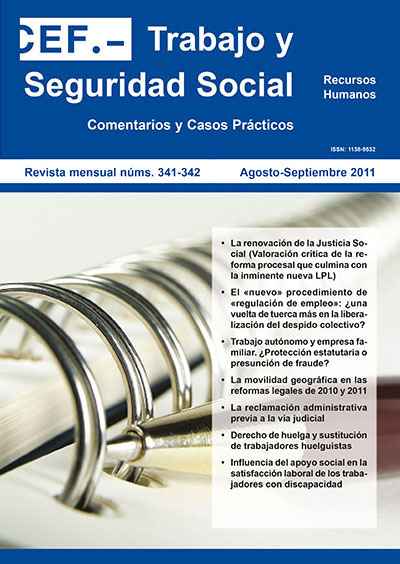El «nuevo» procedimiento de «regulación de empleo»: ¿Una vuelta de tuerca más en la liberalización del despido?
DOI:
https://doi.org/10.51302/rtss.2011.5113Palabras clave:
despidos colectivos, reestructuración de empresas, procedimientos de regulación de empleo, planes socialesResumen
La reforma laboral llevada a cabo por la Ley 35/2010 incidió en una notable flexibilización del despido colectivo, en especial a través del intento de superación de la llamada «incertidumbre aplicativa», tanto administrativa como sobre todo judicial. El objetivo era crear un marco regulador que infunda más confianza a los empresarios para acudir a este mecanismo de reestructuración empresarial, reduciendo la discrecionalidad existente al respecto, tanto en sede administrativa como judicial. A cambio, el empresario debía comprometerse a tomarse en serio los «planes de acompañamiento social», a fin de que las decisiones de reajuste no supusieran una despreocupación extrema por la suerte de los trabajadores afectados, sino que se crearan programas específicos orientados a la mejora de la empleabilidad de aquellos.
Este cambio de modelo regulador tenía que articularse, en el plano práctico, a través de un procedimiento de regulación de empleo adecuado a los nuevos requerimientos, de ahí el mandato legal para reformar en profundidad la regulación reglamentaria precedente. Precisamente ese es el objetivo del Real Decreto 801/2011, que aquí se comenta. Sin embargo, sorprendentemente, el Gobierno quiso aprovechar esta habilitación reglamentaria para modular el alcance de la reforma, de modo que por la vía del incremento de las exigencias documentales, sobre todo para los casos novedosos de regulación de empleo ante situaciones de pérdidas estimadas o eventuales, no actuales, se redujeran las facultades abiertas al empresario para una gestión preventiva del riesgo de pérdida de competitividad, especialmente intenso en situaciones de crisis e incertidumbre de mercados. Sin embargo, el dictamen del Consejo de Estado fue muy crítico contra esta opción, evidenciando reparos sustanciales en ese y otros puntos que obligó a una revisión en profundidad del reglamento proyectado.
La versión definitiva ha recogido buena parte de las sugerencias del Consejo de Estado, pero no todas. Al tiempo, el Consejo de Estado ha mostrado un exceso de celo en el control de este instrumento regulador, yendo más allá de su función consultiva para mostrarse como una suerte de legislador negativo y positivo. El resultado es una regulación en la que se nota claramente la pugna entre dos concepciones diferentes del procedimiento de regulación de empleo y del despido colectivo. De ahí que se planteen importantes problemas teóricos y prácticos. En este trabajo se da cuenta de todo este proceso, se identifican las principales novedades de la regulación, se evidencian los problemas aplicativos más relevantes y se atisban algunas soluciones para los operadores jurídicos.


















